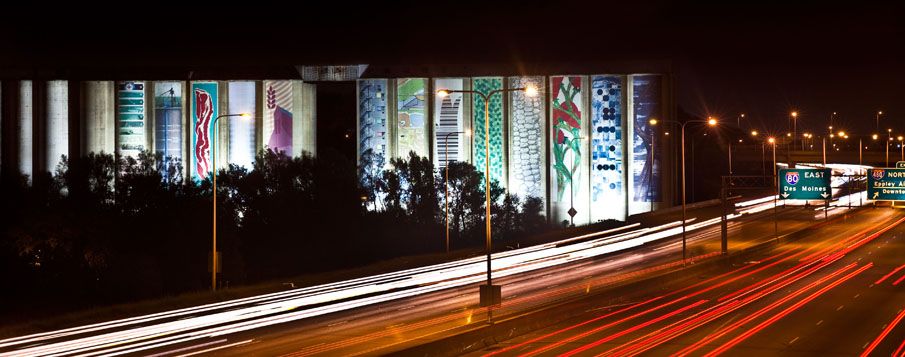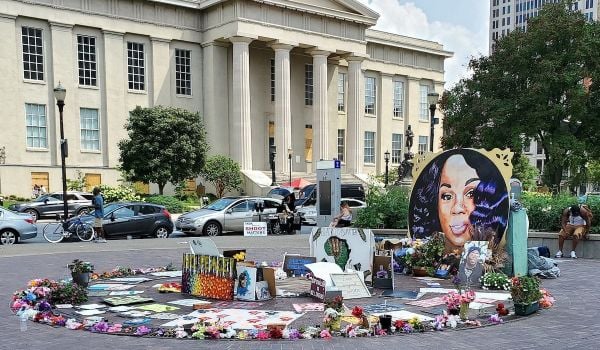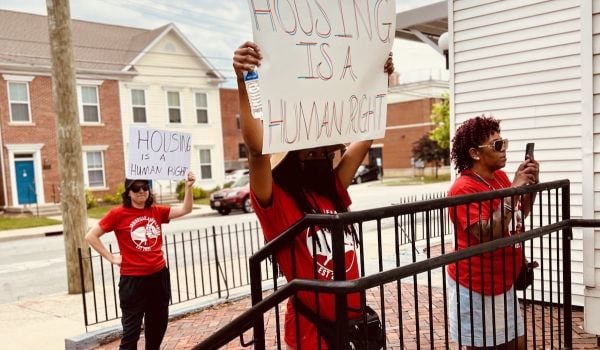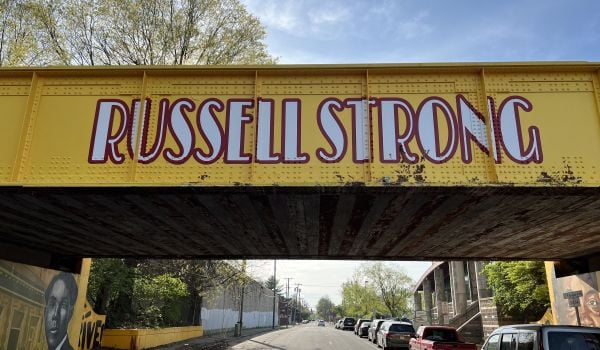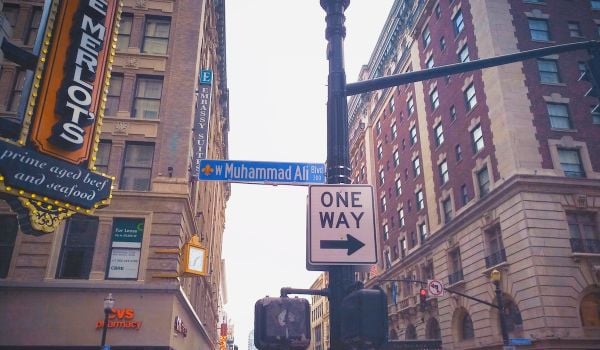Driving into downtown Omaha, it’s hard to miss them: 80-foot tall, empty corn silos, one of which is adorned with a giant piece of bacon, with the caption “Amen” painted on its soaring white trunk. It’s an odd welcome for corn country. Or rather, it would have been ten years ago.
The economy of Omaha is changing and with that change has come a not-so-subtle shift in the way residents are engaging with the city’s landmarks — corn silos, furniture factories and highways alike.
The bacon silo is the work of Anne Trumble, 36, a Nebraska native who remembers toting harvested corn to these elevators as a child growing up on a nearby farm. “They’re pretty big as adults,” she joked recently. Corn was the “heavenly bean” in her family: their bread-and-butter, so to speak. When Trumble grew up, she traded Omaha’s silos for New York City’s skyscrapers. Meanwhile, the silos of her youth emptied out and went from being a beacon of America’s agriculture to “white noise” seen by more than 70,000 commuters who travel Interstate 80 daily.
In 2010, Trumble returned to Omaha and decided that these sights of derelict and decay should become “monumental markers” in the city, a playground to talk about issues such as transportation, food and agriculture. But in a fun way.
Trumble concocted a solution she called “Stored Potential.“The idea was to get local artists to submit designs that can be magnified to fit the colossal specs of the silos and remake the fallow farming sites as markers of the city’s thriving creative culture and untapped promise. She received 500 submissions, from which she chose 13 images, including, of course, the oversized bacon as well as corn and an image of batteries stacked on top of one another. To give a hint of the enormity of the panels that were eventually installed, consider that it took 235 lifts to get the job done.
Following the installation, Trumble decided to host a dinner party at the longest table in town: an 800-foot platform stretched across the base of the silos at the end of the abandoned railroad tracks. The food was prepared by ten local chefs. Staples of Midwest fare, such as bison and corn, made up the six-course meal, served on handcrafted platters carved from local wood. City law did not allow parking on site. So dinner guests parked elsewhere and walked down the trail next to the abandoned railroad tracks to reach the grain elevators — an opportunity to relive the past, said Trumble.
The mosaic of banners has become increasingly intricate since they first debuted in 2010. In 2011, the dinner party was held on a bridge over Interstate 80. The theme for that year’s artwork: transportation. And Trumble appropriately called the dinner “Elevate.”
This notion of rethinking infrastructure and buildings in ways that encourage structures to serve a larger human need is called public interest design. It may be familiar to those in San Francisco, home to the human-centered design firm IDEO, or post-Katrina Biloxi, Miss., where the idea inspired nonprofits such as the Gulf Coast Community Design Studio to build community-oriented architecture. But it is only in the past few years that the idea has begun to spread more widely to smaller cities that are neither major centers of creative commerce nor post-disaster work zones.
After the success of Stored Potential, Trumble left her New York City dream gig as a landscape architect to develop Emerging Terrain, a non-profit research and design collaborative that is interested in working to reshape the built environment of these smaller cities, starting with Omaha.
Jason D’Mello, a 29-year-old Ph.D. student at the University of Louisville, is one person who has already been influenced by the nonprofit’s work. D’Mello created Idea Mornings to inspire collaboration and new ideas in his hometown of Louisville. He’s bridging the divide between research and practice by inviting entrepreneurs, artists and non-profit leaders to meet regularly with thought-leaders, activists and academics. The tossing of ideas back and forth, D’Mello believes, can bring change to Louisville — “all before business hours,” he jokes.
D’Mello and Trumble met through the Millennial Trains Project, a transcontinental journey for the Millennial generation to rediscover America and develop solutions to social problems.
Her work reminded him of the Original Makers Club, a collaborative of entrepreneurs in Louisville who are attempting to “build culture and preserve beautiful spaces,” similar to Trumble.
“I wish I could fly them here for the day to meet her,” D’Mello joked.
After the successful launch of the silos, Trumble was overwhelmed with such requests to mentor others on building their own “silo” project. But while she has advised several communities, none have moved forward with projects.
“Something gets lost when a ‘consultant’ is added to the mix, which is what we would essentially be doing in replicating it elsewhere,” she said.
But in the spirit of learning from others, Emerging Terrain’s next project is modeled off a method pioneered in Atlanta — the BeltLine. The site is one of the largest redevelopment projects in the United States. Essentially a greenway developed along 20 miles of historic railroad corridor crossing 45 neighborhoods, the BeltLine has been in the works since 1999 and like Stored Potential, began as one person’s good idea. In this case, it was an idea floated in Georgia Tech graduate student Ryan Gravel’s thesis.
Trumble’s vision is an Omaha BeltLine that would reconnect North Omaha residents to jobs in South Omaha through transit and, as in Atlanta, use an extinct rail corridor.
This summer, Trumble held a series of town hall style community meetings to include local perspectives. About 500 people showed up. She recognizes that the project is a monumental task, with estimates of upwards of $20 million to pull it off.
But Trumble is fit for monumental tasks. After all, three years ago she started with 80-foot silos.

Esha Chhabra is a journalist who covers social impact, technology for development and public health.

